#alethiometer symbols*
Text
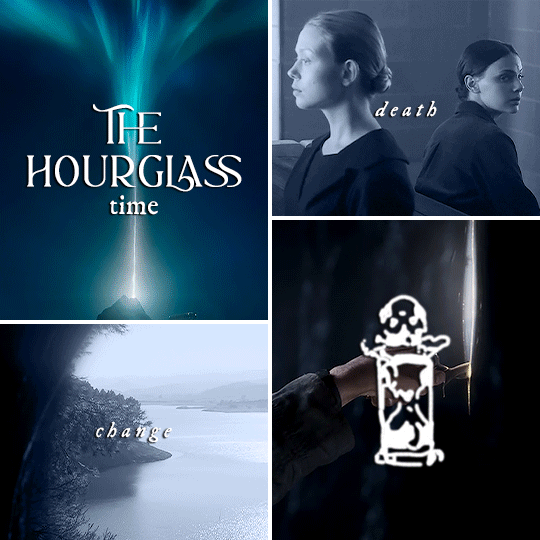
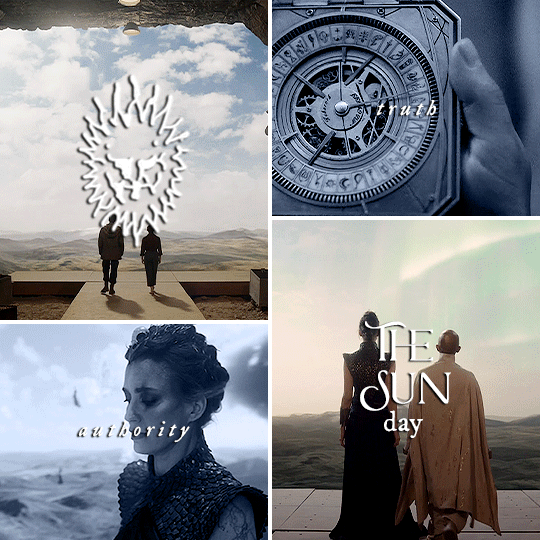




HIS DARK MATERIALS + ALETHIOMETER SYMBOLS (1/6)
#hdmedit#hisdarkmaterialsedit#hdmsource#adaptationsdaily#tvfilmsource#tvfilmdaily#tvfilmedit#lyra belacqua#will parry#marisa coulter#mary malone#ruth wilson#dafne keen#maya edits#alethiometer symbols*#shoutout to aish for being invaluable in the making of this set it wouldn’t have happened without you <3#his dark materials
194 notes
·
View notes
Text
The symbols of the Alethiometer in emoji:
Alpha & Omega - 🅰️🅾️
Anchor - ⚓
Angel - 👼
Ant - 🐜
Apple - 🍎
Baby - 👶
Beehive -🐝🐝🐝
Bird - 🐦
Bread -🍞
Bull - 🐂
Camel - 🐫
Candle -🕯️
Cauldron -🫕
Chameleon -🦎
Compass - 🧭
Cornucopia -📯🍇🥭🌽
Crocodile -🐊
Dolphin -🐬
Elephant - 🐘
Globe -🌎
Griffin -🦁🦅🦂
Helmet -🪖
Horse - 🐎
Hourglass - ⏳
Lute - 🎻
Madonna - 🤱
Marionette - 🪀🪆
Moon - 🌚
Owl - 🦉
Serpent - 🐍
Sun - 🌞
Sword - ⚔️
Thunderbolt - ⚡
Tree - 🌳
Walled Garden - 🧱🥀🧱
Wild Man - 🧔
#On my death bed I will say “I may never have finished a novel but at least I posted on tumblr all 36 symbols of the alethiometer in emojis”#His Dark Materials#The Golden Compass#alethiometer#philip pullman#post o' mine
115 notes
·
View notes
Text

#tattoo#tattoos#hdm#his dark materials#the golden compass#the subtle knife#alethiometer#symbol reader#book tattoos#cool
10 notes
·
View notes
Text

Got my his dark materials tattoo today :)
#personal#3 symbols from the alethiometer#together they make the question 'how can I learn from my fear?'#the candle being knowledge the owl being fear and the anchor being steadfastness
7 notes
·
View notes
Text
Not gonna lie, I’m still having a good time playing the Golden Compass game from 2007 even after all these years. It’s challenging, it’s aesthetically beautiful, very good plotwise (because they included additional materials) and simply fun to play. You can actually see what the creators of the movie really wanted to do and what was taken away from them (and from us), they actually made it closer to the book and included scenes that were cut (AND KEPT THE ENDING, THEY KEPT THE ORIGINAL ENDING)!
#yes I love his dark materials in its every installation#I'm also still enraged about the fact that the golden compass was originally a very good movie adaptation#but a huge chunk of the scenes were cut due to some bloody zealots making protests about it#FUCK 'EM#anyway I remember playing this game as a kid when my mother and I visited our friends in Saint Petersburg#and I remember how hard it was to keep balance when Lyra walked on the roof or on the ship#now however I had more problems using the sloth swing because I couldn't figure out my keyboard configuration#but yeah it was entertaining! I had a lot of fun solving riddles and gaining alethiometer's symbol meanings!
4 notes
·
View notes
Text
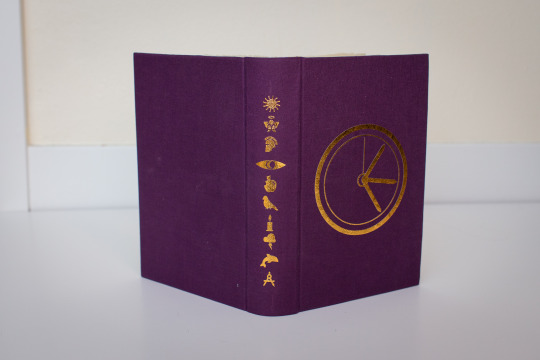
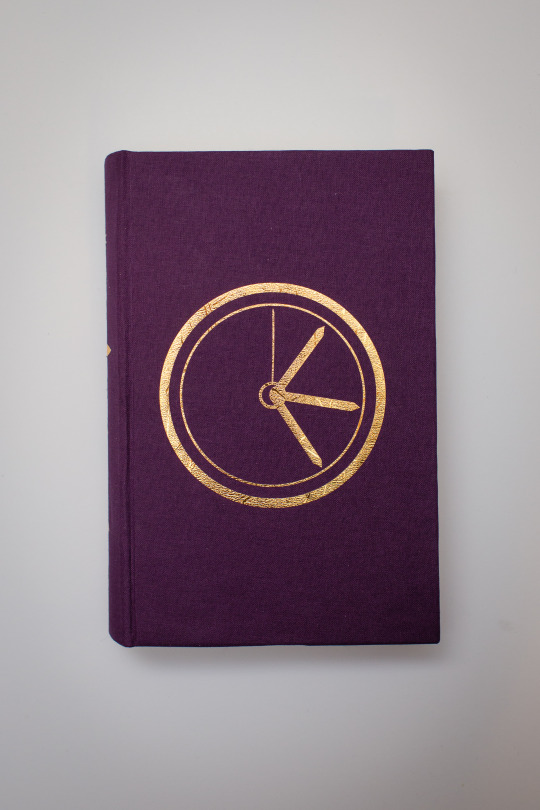
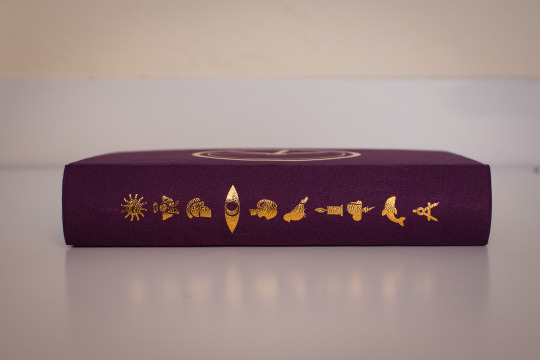
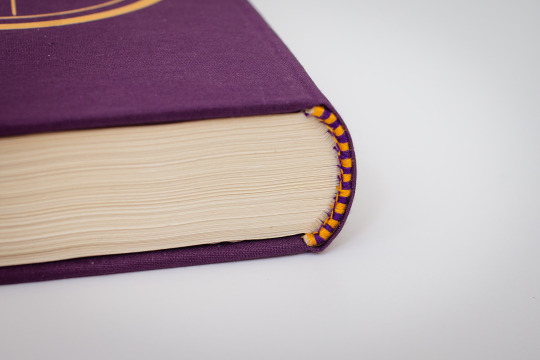


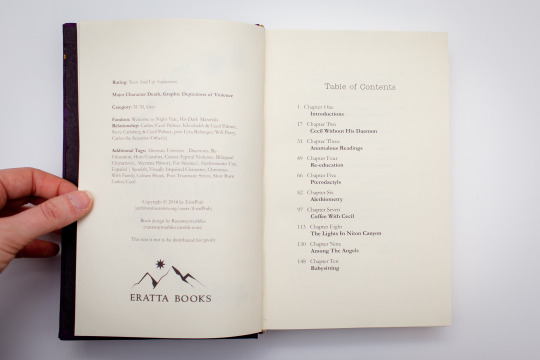
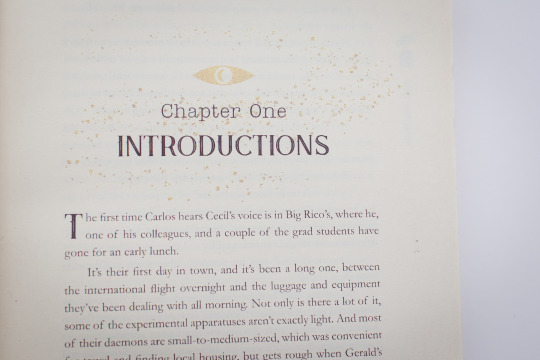
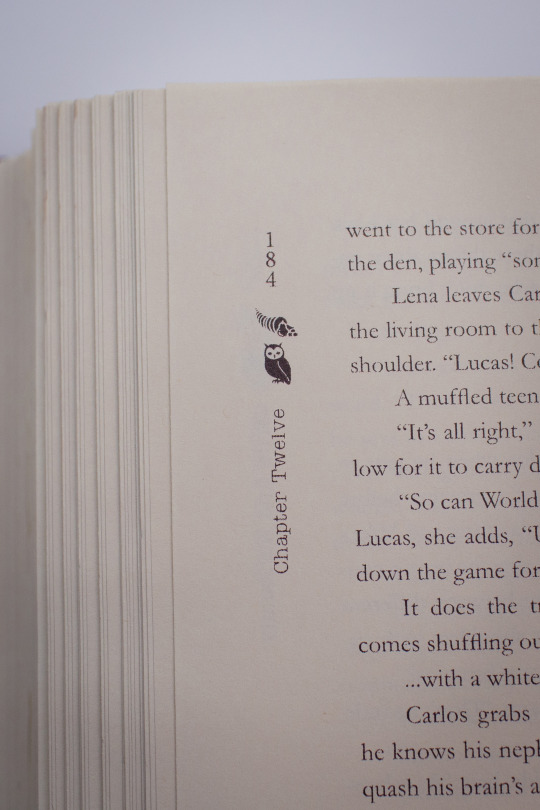

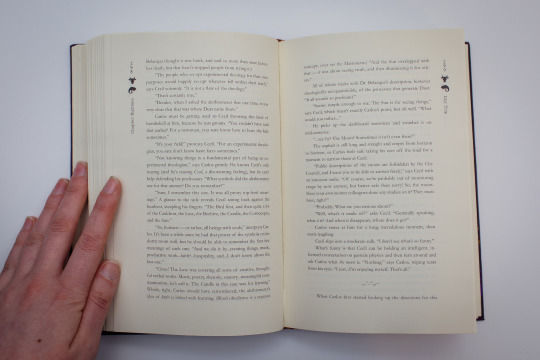

handbinding project: He Says He Is An Experimental Theologian, part 1 of @bicatperson's WTNV/HDM crossover.
This is a remake of one I did three years ago (lent it to a friend, he moved, making an entirely new book seemed like less work than coordinating with the friend of a friend he left it with.) The original typeset was a 6x9 so I had to readjust it to fit 5.5x8.5, and I also changed out the symbols so they'd print more easily. The new ones are a font made by the wonderful rosed from the Renegade Bindery discord.
Fun fact: the arrangement of the hands on the cover also correlates to specific alethiometer symbols because I got that in the weeds about it all.
This cover was a motherfucker and a half because heat transfer vinyl is out to ruin my life: on the original version, I applied the spine art it to the fabric before putting it on the cover, so that I could make sure it was centered. I then tried to use the same HTV to put the symbol on the cover, which did not work no matter how many times and how much heat I tried. (I realized later I'd forgotten to heat the cover first.) So then I tried to peel it up, and it didn't come all the way, so I took that cover off (hooray for wheat paste) and tried putting the vinyl on the fabric before I made the case. despite measuring multiple times, the circle ended up waaay off center. Possibly because I was trying to do this at 11pm. Eventually I just went to Joann's and bought adhesive vinyl, and only adhesive vinyl, even though there was a sale and all vinyl was 40% off. I ended up having to replace the beehive with the night vale eye, because the beehive symbol was a bunch of little lines the adhesive did nOT like, but I think the Night Vale eye looks better anyway.
#handbinding#fanbinding#republic of heaven community radio#welcome to night vale#wtnv#hdm#his dark materials#erinptah#he says he is an experimental theologian#bookbinding#op
490 notes
·
View notes
Text
🤠🐕🦺☃️🐾🏍️🐱🐓Animal Companions Fic Recs🐓🏍️🐱🐾☃️🐕🦺🤠




Check the Top Gun Masterlist post for the latest updated version. 💕
Ao3 Authors: Aphroditedany, Bbr1, BeautifulCreature, Buckybraciole, Callsignyours, Demiclar, Emmedoesntdomath, Indybob, Kazanskysmitchell, Kerbyfullyloaded, LemonsAndSugarMakeLemonade, Lesbiseresin, LoveChildofInsertShowHere, SunMonTue, Teacupivy, ThisisYour_Captain_Speaking, ToukoJalorda003, Whimsicule.
Art Bonus - (coming soon)
> Mythological Creatures & Shapeshifters {🤠🐓}
> Daily Heroes/Animal Care {🤠🐓}
his dark materials / dæmon AU by buckybraciole {T} {🤠🐓}
A series of one-shots about fighter pilots and their dæmons.
Golden Retriever Puppy by bbr1 {G} {🤠🐓}
“Have you ever had a dog?” Jake asks. “Nah, who am I kidding. Of course you haven’t. I’m going to get you a dog.”
Bad Idea! by LemonsAndSugarMakeLemonade {T} {🤠🐓/☃️🏍️}
Bradley: Hey, are you and Ice around?
Well, this is slightly odd Mav thought but he replied anyway.
Yeah, why?
Bradley: We have our baby! We’ll be there in 10.
Mav almost dropped his phone at the reply. What the fuck.
Bradley Bradshaw, you better call me this instant.
A cat named Crow by LoveChildofInsertShowHere {T}
The Meowfect Evening {☃️🏍️}
Sometimes a kitten can make an evening even better
Some Birds Can't Fly {☃️🏍️}
Crow becomes more of a part of the Mitchell-Kazansky family
How Crow Won Slider's Heart {☃️🏍️}
Sometimes a cat will settle an insane debate better than Ice can
The Bumps in Quiet Nights {☃️🏍️}
Ice worries when Maverick takes too long to come back home from picking up dinner
And A Partridge in a Pear Tree {☃️🏍️}
Mav and Ice obtain 3 new family members in the form of kittens
Is it a Racoon? {🤠🐓/☃️🏍️}
Rooster meets the new additions to the Mitchell-Kazansky family and gets talked into getting a pet
Goosebumps {🤠🐓}
Jake and Bradley find the perfect cat for them, which brings up some emotions for Bradley
How to make a Flock {🤠🐓/☃️🏍️}
Mav discovers a box full of kittens on the side of the road on his way to suprise Ice at work
Nick's worst weekend ever by Aphroditedany {T} {🤠🐓}
Nick Bradshaw, Bradley Bradshaw's cat, might unexpectedly bring him closer to a charming co-pilot.
It doesn't mean Nick likes it, though.
Skies of Dust by kerbyfullyloaded {T} {☃️🏍️}
Walking into the sky
Pete Mitchell was fourteen when his daemon settled.
It took him a few years to join her in the sky, wings on his chest and steel all around him.
Every atom of me and every atom of you
The turn of a dial, snapshots of a life, dust all around. Maverick, Iceman, and their daemons in the years between 1987 and 2019.
"'On,' said the alethiometer. Farther, higher. So on they climbed." The Subtle Knife
(or: a series of stories based on the different symbols of the alethiometer, a sequel to Walking into the Sky)
at my side by demiclar {M} {☃️🏍️}
"If there's one thing Maverick is good at, it's taking care of his own." Slider said, throwing his arm around his shoulders and tugging him close. "I'm just glad we can return the favor from time to time."
Pete Mitchell came back from the Dagger mission with PTSD worse than he'd ever experienced before. His family is eager to help, but piecing themselves back together after a decade of separation is a challenge not easily overcome. Pete isn’t the best at accepting help, and the family’s problems go deeper than expected, but they won’t stop trying until they bring everyone home.
Goose the Dog and Mav the Human, the Fun Never Ends by ThisisYour_Captain_Speaking {G}
Man's Best Friend
Maverick is one of the most kind hearted people ever and the things he loves, he does so with everything he has.
Why not let him have a dog?
AKA What if Theo was originally Mav's dog?
Well Well Well, What Have We Here?
It's Fourth of July Weekend and Ice has invited friends and their families over to celebrate. However, before the day of the actual celebration, Mav takes his dog Goose out for a run. Will they be able to beat the storm brewing or will Mav land himself in trouble yet again?
Wrench the Golden Retriever by emmedoesntdomath {T} {☃️🏍️}
“Mav, please tell me you didn’t get us a dog.”
Silence.
He sighed.
The contractually obligated hey-I-bought-a-dog-without-asking-and-then-gave-it-a-name-you’ll-hate-but-you-should-still-love-me fic
call it what you want by lesbiseresin {M} {🤠🐓}
“Shit, Mav,” Bradley says through a laugh as he squats down, leaving his beer on the railing so he has both hands free to stick out. “You finally get me that dog I was always asking for?”
It’s another joke. He knows that Theo belongs to Penny and Amelia, but there has to be a reason Maverick is bringing this up.
“You caught me,” Maverick deadpans. Bradley can see Penny elbow him out of the corner of his eye, but he doesn’t bother looking up, too engrossed in the happy pants Theo is letting out as Bradley switches to scratching under his chin. “You could say I did. Sort of.”
“Sort of, huh?”
(alternatively: jake & bradley getting their shit together ft. theo the dog)
Dust is Everlasting (And Love Even Moreso) by ToukoJalorda003 {M} {🤠🐓/☃️🏍️}
If Time Rewound to Dust (Love Would Endure Anyway)
All Rooster had ever wanted was to work for Jurassic World - his godfather did, and for his whole life, it had been his dream.
Now he finally had it, and he…wasn’t so sure how he felt about Hangman. The man was just too dangerous, too unpredictable, and Rooster feared it would end in disaster.
…But disaster had found them anyway, and now it was starting to look like it was too late to accept Hangman’s offer for a date. Damn.
When Dust is all That Remains (Love is Eternally Present)
After the events of the park’s catastrophic closing, Bradley just wanted to rest. Maybe take a nap and remind himself what he’d nearly had.
But he couldn’t do that, because an active volcano was going to wipe out the remaining dinosaurs - including Jake’s raptors.
…And if it was possible, he wasn’t going to let that happen. Maybe, while he was at it, he’d finally get that date, too.
be the ocean where I unravel by whimsicule {T} {🤠🐓}
He’s not even thirty years old. A lieutenant in the United States Navy. A highly-decorated aviator with two air-to-air kills. And he’s suddenly gone ahead and become scared of the goddamn sea.
What a fucking joke.
make a lil' room for me by callsignyours {G} {🤠🐓}
Jake somehow ends up with Bradley's dog.
The Tiniest Problem by BeautifulCreature {G} {🤠🐓}
Bradley has an allergic reaction to his and Jake's new puppy.
Mine, Immaculate Dream by kazanskysmitchell {M} {☃️🏍️}
After the ever-so-stressful Dagger mission, Pete Mitchell is tired and craves some normalcy. It's seemingly difficult for him to return to normal this time, and his protective (and very worried) husband can't help but notice the changes in Pete's mental health. After an official PTSD diagnosis, being permanently grounded, and the adoption of a service dog, Pete Mitchell attempts to adjust, but can't do it without the help of his wingman and their adopted and dysfunctional family.
(+ art from Cannibal_Hellhound)
better than your best dreams by teacupivy {M} {🤠🐓}
“Hey,” he says, nudging Bradly with his toes. “You brought Aubergine in, right?”
Jake watches Bradley look up from his screen, stare into the mid distance, and decide to lie to him.
“…Yes.” Tense and robotic, he slides his laptop onto the coffee table and slips out from beneath Jake’s legs. “Unrelated, I’ll be right back.”
With our pets, a house becomes our home by SunMonTue {E} {🤠🐓}
Jake adopts a puppy and then proceeds to fly across the country to take up a flight instructor position at Corpus Christi where Bradley is the vet (DVM) that Jake takes Brisket to once he arrives. Bradley asks him out. MeetCute.
Domestic Bliss by indybob {T} {🤠🐓}
Jake has had the longest week of his life. Between hops, training, and instructing, he’s worn out. Noticing how exhausted his husband is, Bradley takes it upon himself to go above and beyond to give Jake the most relaxing evening and weekend possible.
Or: Much like Jake in this story, I’ve been very busy for the last couple of weeks, so I’m using this as my own form of catharsis.
Feat. Brisket the Dog
Come on baby light my fire… by SunMonTue {E} {🤠🐓}
An apartment fire alarm at 1am featuring Jake in his underwear and Bradley with kittens.
#Animal Companions Recs List#hangster#sereshaw#hangaroo#icemav#iceman x maverick#bradley rooster bradshaw x jake hangman seresin#tom iceman kazansky x pete maverick mitchell#bradley rooster bradshaw#jake hangman seresin#tom iceman kazansky#pete maverick mitchell#🐈red🐈furry🐈cat🐈tag🐈
74 notes
·
View notes
Text
Tips To Consider When Writing A Fantasy Religious Story
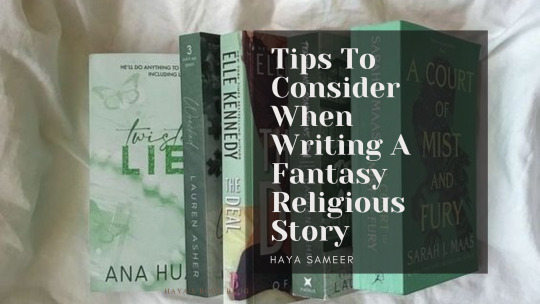
This was requested by @saltykidcreation if you want to request something send me an ask!
A fantasy religious story is a fantasy story where, even if a God-like character does not exist, true biblical values are made obvious in the book's theme because of the author's worldview. I personally don’t write fantasy religious stories, however, since this was requested I decided to come up with some tips for this genre.
Establishing a Rich Mythology
At the heart of every captivating fantasy religious story lies a well-crafted mythology that breathes life into the beliefs, deities, and rituals of your fictional world. Just as our world's religions have intricate backstories, your fantasy realm's mythology provides the framework for understanding the spiritual landscape. Here's how to create a mythology that resonates:
Deities and Powers
Develop a pantheon of gods and goddesses, each with distinct personalities, domains, and motivations. Consider drawing inspiration from real-world mythologies or inventing entirely new divine beings. For instance, in Neil Gaiman's "American Gods," gods from various cultures manifest in modern-day America, reflecting changing beliefs.
Rituals and Traditions
Infuse your world with rituals, ceremonies, and festivals that reflect the beliefs of your fictional religion. Whether it's a solemn pilgrimage to a sacred site or a joyful celebration of a deity's favour, these rituals offer opportunities to reveal cultural norms and values. Take the example of "The Name of the Wind" by Patrick Rothfuss, where the University's Archives hold religious significance, connecting knowledge and faith.
Holy Texts and Prophecies
Craft ancient texts, prophecies, or scriptures that guide your characters' beliefs and actions. These texts can hold hidden truths, enigmatic predictions, or moral codes that shape the course of the story. In Philip Pullman's "His Dark Materials" trilogy, a mysterious device called the Alethiometer becomes a tool of divination, echoing themes of destiny and belief.
Cultural Impact
Consider how your fictional religion influences art, architecture, fashion, and daily life in your world. Are there specific symbols associated with the faith? Does the religion inspire grand cathedrals, tranquil monasteries, or vibrant marketplaces? J.K. Rowling's "Harry Potter" series exemplifies this through the majestic Hogwarts Castle and its hidden rooms dedicated to various founders' beliefs.
A well-developed mythology adds depth and authenticity to your fantasy religious story, enriching readers' immersion and emotional engagement. As your characters interact with these elements, their beliefs will take centre stage, shaping their decisions and driving the narrative forward.
Worldbuilding and Cultural Depth
Creating a compelling fantasy religious story extends beyond the spiritual realm—it involves crafting an immersive world where faith intertwines with culture, society, and daily life. As you build your fantastical universe, keep these worldbuilding aspects in mind to ensure a rich and authentic backdrop for your narrative:
Cultural Diversity:
Just as our world hosts a tapestry of cultures, your fantasy realm should embrace diversity. Explore how different regions or communities within your world interpret and practice the same religion. George R.R. Martin's "A Song of Ice and Fire" series masterfully showcases distinct religious beliefs held by various societies, adding layers of complexity to the narrative.
Social Impact:
Consider how religion shapes social hierarchies, class systems, and power dynamics. Does the priesthood hold political sway? Are certain religious groups marginalized or revered? In Ursula K. Le Guin's "The Left Hand of Darkness," the planet Gethen's religious beliefs are deeply tied to its unique genderless society.
Iconography and Architecture:
Infuse religious symbolism into architecture, art, and everyday objects. Temples, sculptures, and artefacts can embody beliefs and tell stories within your world. The stained glass windows of Notre Dame Cathedral in Victor Hugo's "The Hunchback of Notre Dame" visually depict biblical narratives while reflecting the spiritual essence of the setting.
Language and Terminology:
Develop specialized terminology, prayers, and phrases specific to your fantasy religion. This linguistic distinctiveness adds authenticity and depth to the faith. J.R.R. Tolkien's "The Lord of the Rings" features languages like Elvish that enrich the cultures and religions of Middle-earth.
Impact on Conflict and Plot:
Explore how religious differences can drive conflict or cooperation within your story. Religious tensions can lead to political strife, wars, or alliances. In Frank Herbert's "Dune," the complex interplay between the Fremen's religious beliefs and the political landscape fuels the narrative's intrigue.
Remember, effective worldbuilding integrates religious aspects seamlessly into every facet of your fictional world. By intertwining faith with culture, you'll create a vivid and immersive environment that enriches your readers' experience and deepens their connection to your story.
Weaving Themes of Faith and Doubt
Central to any fantasy religious story are the themes of faith, doubt, and the profound quest for meaning. These themes can elevate your narrative, sparking introspection and emotional resonance. Here's how to skillfully weave these threads throughout your story:
Character Beliefs
Explore how characters' beliefs shape their worldviews, actions, and interactions. Does a protagonist's unwavering faith lead them on a heroic journey, while a sceptical character questions the mystical elements surrounding them? In C.S. Lewis's "The Chronicles of Narnia," characters' diverse beliefs guide their roles in the unfolding saga.
Spiritual Journeys
Craft character arcs that mirror spiritual journeys, complete with challenges and revelations. Allow characters to grapple with doubts, undergo transformative experiences, and emerge with a deeper connection to their faith. The character Eowyn in J.R.R. Tolkien's "The Lord of the Rings" confronts her inner struggles and finds a newfound purpose.
Crisis of Faith
Introduce moments of crisis where characters' faith is tested to its limits. These moments can lead to internal turmoil, moral dilemmas, and choices that define their paths. In Philip K. Dick's "Do Androids Dream of Electric Sheep?" the protagonist questions the nature of humanity, blending themes of religion with questions of identity.
Divine Intervention
Explore the concept of divine intervention and its impact on characters' lives. This can be a source of guidance, trials, or even scepticism. In "American Gods" by Neil Gaiman, the gods' involvement in human affairs raises questions about their true motivations and the nature of belief.
Existential Quests
Delve into existential themes as characters search for meaning beyond the material world. Incorporate quests that transcend physical boundaries, encouraging characters to uncover truths about existence, mortality, and the afterlife. Terry Pratchett and Neil Gaiman's "Good Omens" humorously navigates themes of fate, destiny, and the cosmic battle between good and evil.
By exploring the intricate balance between faith and doubt, you'll create characters who resonate with readers on a deeply human level. These themes not only enrich your narrative but also invite readers to ponder their own beliefs and uncertainties
Utilizing Symbolism and Allegory
In the realm of fantasy religious storytelling, symbolism and allegory serve as potent tools to convey layers of meaning and depth. These literary devices can bridge the gap between the fantastical and the profound, enriching your narrative in powerful ways:
Symbolic Artifacts
Introduce artefacts or objects that hold symbolic significance within your world. A mystical amulet, an ancient tome, or a sacred tree could embody themes of faith, wisdom, or protection. Consider the One Ring in J.R.R. Tolkien's "The Lord of the Rings," representing the corrupting influence of power.
Allegorical Journeys
Craft allegorical quests that mirror spiritual journeys or moral dilemmas. Characters might embark on physical journeys that parallel inner transformations, mirroring the trials and growth inherent in belief systems. In John Bunyan's "The Pilgrim's Progress," the protagonist's journey to the Celestial City mirrors the Christian path.
Metaphorical Creatures
Introduce fantastical creatures that symbolize spiritual concepts. A mythical phoenix representing rebirth or a guardian dragon embodying both danger and enlightenment can add layers of meaning to your narrative. In "The Chronicles of Narnia," Aslan the lion is a symbolic representation of Christ.
Cosmic Forces
Use cosmic events or celestial phenomena as metaphors for divine influence or moral alignments. A comet's appearance could herald significant events, while an eclipse might signify moments of transformation or impending conflict. The Dark Tower series by Stephen King weaves cosmic forces into the fabric of its multiverse narrative.
Subtextual Commentary
Employ allegory to comment on real-world issues or philosophical concepts. By grounding your fantastical narrative in allegorical discussions, you invite readers to reflect on broader themes while engaging with your story. George Orwell's "Animal Farm" is an allegory for political corruption and societal manipulation.
By artfully integrating symbolism and allegory, you add depth and resonance to your narrative. These devices not only enhance the fantastical elements of your story but also invite readers to explore the layers of meaning hidden beneath the surface.
Crafting Moral Dilemmas and Choices
A hallmark of captivating storytelling is the inclusion of moral dilemmas that challenge characters' beliefs, forcing them to confront their convictions and make difficult choices. Within the realm of fantasy religious stories, these dilemmas become even more potent, as characters navigate the intersection of faith, ethics, and personal growth:
Clashes of Belief
Introduce conflicts where characters' divergent beliefs clash, sparking debates and raising questions about the nature of truth and morality. Such clashes can lead to both external conflicts and internal struggles. In "The Golden Compass" by Philip Pullman, characters' differing beliefs influence their actions in a world with soul-representing daemons.
Test of Principles
Develop scenarios where characters must make choices that challenge their faith or require them to compromise their values. These choices can lead to soul-searching moments that reveal the depths of their character. Guy Gavriel Kay's "Tigana" explores characters' moral choices amid political and religious conflicts.
Consequences of Devotion
Examine the consequences of extreme devotion to a religious cause. Characters who blindly follow their faith might be driven to commit ethically questionable acts, raising questions about the balance between devotion and ethics. In "The Sparrow" by Mary Doria Russell, the characters' missionary zeal leads to unforeseen moral dilemmas on an alien planet.
Doubt and Redemption
Narrate character arcs that involve doubt and eventual redemption. Characters who experience crises of faith might embark on journeys of self-discovery and growth, ultimately finding renewed purpose or understanding. In "The Magicians" by Lev Grossman, the protagonist's journey of doubt and rediscovery aligns with themes of magic and faith.
Personal Growth Through Struggle
Showcase characters who emerge stronger from moral challenges, reflecting personal growth as they navigate the complexities of their beliefs. These experiences can lead to a deeper understanding of faith and a more profound connection to the divine. Jacqueline Carey's "Kushiel's Dart" features a protagonist whose unique perspective challenges and evolves her understanding of religion.
By infusing your narrative with moral dilemmas, you encourage readers to grapple with complex questions, fostering empathy and introspection. These dilemmas illuminate the nuances of faith and the intricate choices that define the paths characters undertake.
I hope this blog on Tips To Consider When Writing A Fantasy Religious Story will help you in your writing journey. Be sure to comment any tips of your own to help your fellow authors prosper, and follow my blog for new blog updates every Monday and Thursday.
Looking For More Writing Tips And Tricks?
Are you an author looking for writing tips and tricks to better your manuscript? Or do you want to learn about how to get a literary agent, get published and properly market your book? Consider checking out the rest of Haya’s book blog where I post writing and publishing tips for authors every Monday and Thursday! And don’t forget to head over to my TikTok and Instagram profiles @hayatheauthor to learn more about my WIP and writing journey!
#hayatheauthor#haya's book blog#haya sameer#haya blogs#writers on tumblr#writer community#writer tools#writer blog#writer stuff#writer wednesday#writer tips#creative writing#writers of tumblr#writerscommunity#writeblr#writing community#writer spotlight#writer things#writing prompt#writing tools#writing stuff#writing#writing life#writing inspo#writing help#writing advice#writing inspiration#writing ideas#writing things#writing tip
87 notes
·
View notes
Text

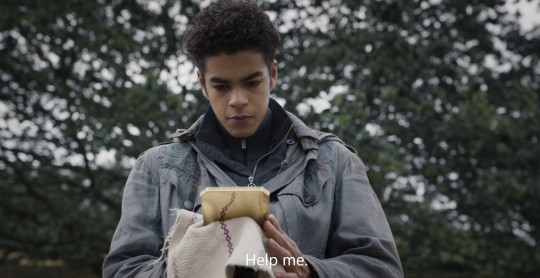
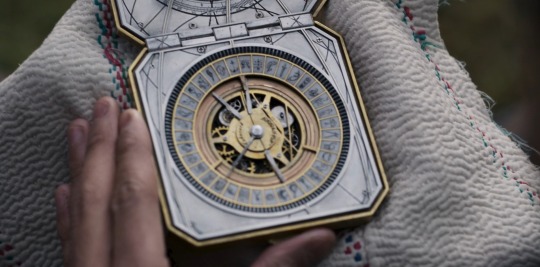
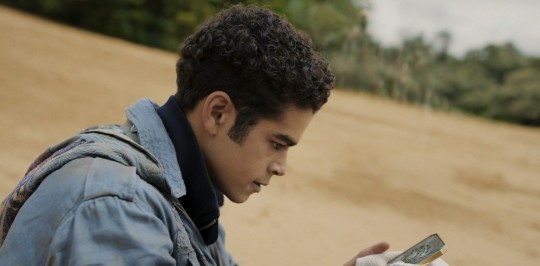
Watching Will desperately beg the alethiometer to tell him where Lyra is made my heart ache so much for him. Like, my dude, you know you can't read that thing. You know that. I can't remember if there was ever a moment like this in the book, but watching this I realized it must have been absolutely killing him to know that the answer is right there in his hands, if only he knew how to ask the question and read that answer. But he's not Lyra, he doesn't have the Dust-given gift of reading the alethiometer, nor does he have the books of symbols and knowledge required to decipher them. The one thing that could give him all he needs right now can fit in his palm and yet is completely useless in his hands.
I know the real heartbreak isn't here yet but man... This shit hurt 😭
#his dark materials hbo#his dark materials spoilers#his dark materials#hdm spoilers#hdm s3#will parry#lyra silvertongue#lyra x will#will x lyra#silverparry#panjava
181 notes
·
View notes
Text
So weird thing that I have kind of background believed for a long time with the alethiometer in His Dark Materials: I think that most people can't read it mostly because they think they can't, because they know it's difficult (or look at it and don't instantly understand) and that there are *rules*, and they get caught up in that. This is not me trying to be all "rip to them but I'm different" but I think there's also something in the way that Lyra is able to do it, but adults can't, that is aside from the whole deus ex machina.
The series as a whole puts a lot of emphasis on the difference between how children act, think and feel differently to adults. The difference between knowledge and intuition is heavily emphasised. We also know that the whole thing with Dust is that it isn't attracted to children because of this delineation.
There is also the fact that the alethiometers come from a time when symbols were heavily used and everyone would know and understand a lot of meanings for each symbol as second nature. This is contrasted with the scene in The Subtle Knife when Lyra is hooked up to the Cave and she gets the screen to talk to her in the symbols she's learned because that's how she frames the idea of "asking the alethiometer" which she is basically trying to replicate with it, but she tells Mary that she reckons she could get it to speak in words. Which she does, and she understands basically everything that is said to her, though the angels throw some metaphor in there too that isn't instantly obvious.
Now what if, as those symbols fell out of common use, people started making books of reading for those that came after. They knew that the use of symbols was starting to fall out of common parlance, so they listed down all the symbol meanings that they could think of, and when they read the alethiometer, it would stop on the symbol a certain number of times, and when it did it meant this meaning of that symbol, so they noted that down too.
And so it becomes a known thing that if you are going to read the alethiometer, it's *going to be hard work*. You are *going to have to learn all the meanings* and *exactly* what it means at all the different levels. The emphasis is on *knowledge* at all times, so if you are able to access an alethiometer in the first place, you are going to know that you *have to know all this* before you start.
Meanwhile, we have Lyra. She's a child, and on top of that, she as a person is a creature of instinct and stubbornness. But she is also a child that has been brought up in an academic background. Even just in passing, she has a lot of higher level knowledge of metaphor and symbolism than her peers. While she is told that she should need the books of reading, she is also in a dire situation, she has the device that has the answers, and nothing to lose by trying to work with it.
And she does. There are times when her symbol knowledge fails her, or she doesn't have the context to work it out (the chameleon, she doesn't recognise the animal and also doesn't know the myth that they don't eat or drink and just live off air; the symbols that added up to mean that it was telling her that the 'ghost' was a child with no daemon) but for the most part she is able to *intuit* the meaning by herself but also look at the way it is framed in the books. She translates the list of meanings into very conversational interactions.
I always took her loss of the ability to read it as one of the final indicators of her transition from intuitive child to a more logical adult, and how that changes her from a child who is willing to just have a go at something, to try and make it work because it's her only source of power, to an adult whose brain works in knowledge and facts and "the right way to do things".
Part of this is that I have a headcanon that if you were to put child Lyra next to someone who had studied the books, and asked them to get the answer to the same question, you would see different readings come out of them: they would get the same final answer, yes, but I don't think the way they would "read" it would be the same. I think the symbols would be in a different order, or they would have been different symbols chosen based on the person reading them.
I think part of you getting into the frame of mind described in the books is both you being receptive to information, but also engaging Dust/the angels in such a way that they can try and present you with the information in such a way that you will understand as best as they can. Say again with Mary: when the Angels use the metaphor of "play the serpent", I think they were playing in her wheelhouse. If she had been from a completely different culture or religious background, I think they would have found a different metaphor.
Think of it as playing a game of charades. If you know the person well, you will give them clues based on things they understand, in jokes or shared frames of reference, and you'll get to your answer faster. The symbols were put there by people who understood them all clearly at the time and thought everyone else would always understand them. But looking at a current comparison, is someone in two hundred years going to look at a text with 🍆 in it and instantly know the meaning we have ascribed to it?
Meanwhile the other person in this scenario, who had learned the meanings, would have spent their life learning the "correct" meanings. Memorising every meaning of each symbol *as it was written in a book* by a person who was writing down how they personally read the alethiometer. I think they would probably get a very different series of symbols.
#his dark materials#hdm#northern lights#golden compass#lyra belacqua#lyra silvertongue#alethiometer#meta#headcanon
341 notes
·
View notes
Text
Using the Alethiometer as a Tool of Divination
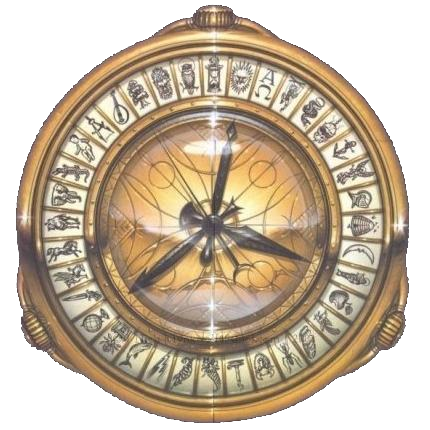
About the Alethiometer
The Alethiometer is a divinatory tool from Phillip Pullman's His Dark Materials series. The word 'alethiometer' is a compound of Greek root aletheia- (truth) and suffix -meter (measure), literally meaning 'truth measure'. It resembles a compass or pocket-watch in appearance, with four needle-like hands anchored to the center and a golden casing -- giving rise to its alternative name, The Golden Compass. The Alethiometer has thirty six symbols painted around the rim of the dial, each with meanings on multiple different levels (referred to by Lyra in the book as a 'ladder' that one had to travel up and down) that are contextually and subjectively dependent.
To use it, an Alethiometrist uses the dials on the sides of the device to move three of the four hands to point at three symbols representing the question they wish to ask. The Alethiometrist must hold this question in their mind and enter a loose, almost meditative state, during which the fourth dial shifts from symbol to symbol to indicate the answer. The querant must not only note which symbols the needle stops at and the order it does so, but also how many times it may have stopped at the same symbol, which could (but not always!) indicate which 'rung' of the 'ladder' the meaning may be found at. The symbols must then be taken together as a whole to translate and interpret the full meaning. The Alethiometer moves quickly, and so the Alethiometrist must be quick-witted and pay close attention to what it is trying to say lest they miss parts of the answer.
The Alethiometer was invented in Lyra Silvertongue's world in the 17th century by Pavel Khunrath, an experimental theologian who had originally intended to use it for astrological purposes, but expanded his research once he realized the device could answer questions beyond those dealing with the zodiac. In much the same way people of our world use tools such as tarot cards and runes, the Alethiometer was used to 'learn the truth' via communication with Dust, the elementary particle responsible for the consciousness of sentient species across the multiverse. Only six of these devices were ever created, and each of them had a somewhat unique appearance beyond the common resemblance to a compass.

Using the Alethiometer
As with any divinatory tool, reading and interpreting an Alethiometer is a deeply personal process that requires no small amount of intuition. It is for this reason that learning the symbols must go beyond mere rote memorization. Each of the 36 symbols on the dial has a primary 'surface' denotation and multiple, more abstract subsidiary connotations. Similar to tarot cards, each symbol can also have a multitude of different meanings beyond those that are commonly held due to the Alethiometrist's personal beliefs, views, culture, and life experiences. No symbolic meaning is universal! The Alethiometer may add to the multiplicity of the symbols by revealing new meanings to the querant relevant to the question at hand.
Additionally, Alethiometrists should look in to academic topics such as the study of semiotics (the study of signs and symbols and their use or interpretations), lexical semantics (the study of word meanings and word relations), and pragmatics (the study of how context contributes to meaning), especially in linguistic, anthropological, and sociological contexts. By combining these epistemologies, an Alethiometrist will have a firm foundation upon which to expand their knowledge and understanding not only of the symbols and meanings of the device itself, but how they might fit together in a syncretic and holistic manner.
Using an Alethiometer is a co-constructive exercise between yourself and the device. When posing a question to the Alethiometer, one should be calm, relaxed, loose in both body and mind, and open to whatever answers will be revealed to you. Remember: It can only the truth, but, depending on the question and context, your device may omit certain details or present information in an alternative light, and so each answer should be carefully examined and alternative interpretations should be considered. Discernment and the ability to read between the lines is important when using an Alethiometer. The Alethiometer is also sensitive to the moods of its reader and may become reluctant to answer questions when you aren't in the right state of mind, especially when it knows you might not like the answer it has to offer.
As with any divination practice, you should always keep a detailed journal to record your observations and take notes upon any impressions you get from your Alethiometer during readings. With patience and practice, reading the Alethiometer will become quicker and easier as you become familiar with your device's individual personality and moods and learn how to intuit the answers to your questions.
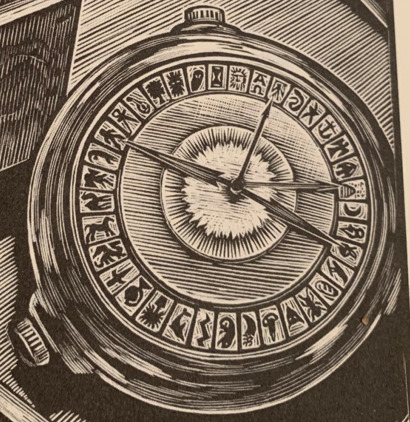
Alethiometer Simulacra:
Unfortunately, we do not have access to Lyra's world and thus do not have access to any of the Alethiometers that exist there there. Unless you have thousands of dollars to spare to commission a custom Alethiometer from a jeweler or watchmaker, or are able to buy one of the Limited Edition replicas of the 2007 film version produced by the Noble Collection that occasionally appear for resale online, access to the physical Alethiometers of our world is similarly restricted.
Luckily, I have found a handful of working substitutes in the form of web-based apps, computer programs, phone apps, and other alternatives. Any of these Alethiometers are viable to use, though some might work better for you than others. In addition to links, I've included my own notes and thoughts on each below.
The Emojicompass/The Emoji Alethiometer (Web & ios App)
The Emojicompass has to be my favorite Alethiometer of the bunch, mainly due to its charming presentation (I mean, come on, it uses emojis) and the inclusion of three dials/needles for user input. When moving your dials by click-and-drag to each symbol, a brief blurb will pop up to remind you of its meaning(s). Each answer returns three symbols, and will list one of the three associated meanings included with the app (which may be a bane or a boon depending on your reading style). It can also be accessed through mobile internet browsers, meaning Android users can also make use of it through bookmarking it and accessing it through said mobile browser, or adding the webpage to their home screens.
This is the version I personally use the most. The use of emojis as substitutes for the symbols upon the dial further contributes to the technomagickal nature of this particular iteration, which I think is particularly fitting. Because it exists as an app on my phone, it travels everywhere with me like a real Alethiometer would, and I feel more 'bonded' to it than any of the other versions on this list.
The NeonAvis Alethiometer (Windows & MacOS & Linux)
Retrieved via Wayback Machine from a site last logged in 2008, the NeonAvis Alethiometer is possibly the oldest Alethiometer on the list. The hands are moved by clicking and dragging the dials, and the question is posed by clicking the center of the compass. Each answer returns a whopping six symbols, and lists one of the meanings included with the app. This particular version is my second favorite because it actually gives you the ability to edit the meanings of each symbol yourself (with each symbol having up to six meanings). You can increase and decrease the window size using +/-. This version also has an Italian translation.
Because this version had to be recovered with Wayback and it took a rather considerable effort to download it, I have decided to host a copy of it myself and others via Google Drive, which is linked above. Along with the three OS versions, I have also managed to retrieve an Italian translation of the app as well as the source code. The creator of this app, Wendell M Jr. (aka NeonAvis), has listed it as freeware and open source, so if anyone has the knowledge to tinker with it, you are open to do so.
Note: If you try to add more than six meanings to a symbol in the .txt file containing said meanings, the program will read it as corrupt and stop working properly. Resetting the meanings file to default returns it to proper operation.
The Artemis-Beta Alethiometer (Windows & Mac OS)
This version of the Alethiometer has a very simple presentation compared to others on this list but is no less effective. It too has three dials/needles for user input, but requires a scroll-wheel on a mouse to move the dials. Laptop users may run into the issues here; I managed to get it to work by pinching my fingers in the traditional 'zoom in' gesture. This version moves very quickly and requires you to pay close attention to the fourth needle. Each answer returns three symbols, but offers no meanings, leaving it up to the reader to discern and interpret the level of meaning for each symbol.
Because of this, I feel that this version is actually the closest simulation of a real Alethiometer.
Alethiometer: Magical Oracle/The Magical Oracle Alethiometer (Android App)
The Alethiometer: Magical Oracle app features a 3D rendered Golden Compass clearly based upon the BBC show's version. It is my least favorite of the apps because of two reasons: there is only one dial/needle for user input, severely limiting the questions you can ask, and the app itself never seems to remember any settings customization, meaning you have to reset it to your preferred specifications each time you open it. However, each answer returns five symbols, and will list one of the three associated meanings included in the app. It also includes a meanings glossary within the app menu that you can consult. I am unsure if there is an iOS version.
The Chartomancy Alethiometer (Gyromancy-based)
This iteration is a printable PDF adapted for gyromancy-based chartomancy, though I suppose it could just as easily be used as a pendulum board. It's pretty straightforward to use -- you spin a top and take note of where it comes to rest. What I like most about this one, however, is the helpful journal/interpretation template the author has included for recording your questions & answers, which also encourages you to think about alternative meanings to the answer you've been given. They also include an extensive personal glossary of interpretations of each symbol, which is an excellent example of an Alethiometrist discovering new meanings beyond the few we were provided with in His Dark Materials.
The 3d6 Alethiometer System (Dice-based)
I kind've adore this version mainly due to the clever usage of the dice in place of a watch-like object with hands and symbols. Two of the dice give you the number corresponding to a specific symbol, and the (optional) third gives you the meaning. While it isn't exactly a 'traditional' Alethiometer, it could work just as well, as you still have to hold your question in your mind while rolling the dice to divine your answer. The linked post also includes three or more levels of meanings for each symbol, with some meanings added or tweaked by the author. Major kudos to @hillbillyoracle for coming up with it!
The Alethiometer Oracle Cards by Eva Deverell (Printable Oracle Deck)
Finally, we come to the Alethiometer Oracle Cards. The author provides a link to download a printable deck of 36 cards based upon the symbols of the Alethiometer (it's advised you print these off on thicker paper like cardstock) as well as a custom deck box. The deck can then be consulted as a traditional oracle deck. The author also helpfully provides a few different ways to help memorize the symbols and their meanings. Nevertheless, despite my personal feelings, this iteration could still prove useful to some aspiring Alethiometrists.
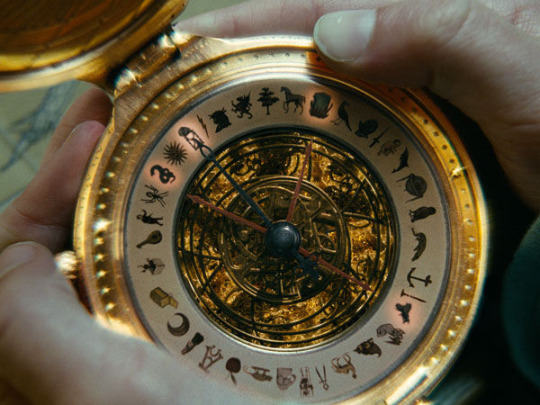
Symbol Meanings:
Here are the 36 symbols of the Alethiometer and the meanings they are canonically associated with, according to the books and material provided by the author and publisher, and are unfortunately very Western and Christian-centric, mainly due to the subject nature of the books in question. Please remember that these are meant only to be starting points for you in your journey as an Alethiometrist. As I explained above, everyone's understanding of the meanings of each symbol is contextual and subjective, and no two Alethiometrists will interpret the symbols the same exact way.
Hourglass - Time, Death, change ...
Sun - Day, Authority, truth ...
Alpha and Omega - Finality, Process, inevitability ...
Marionette - Obedience, Submission, grace ...
Serpent - Evil, Guile, natural wisdom ...
Cauldron (crucible) - Alchemy, Craft, achieved wisdom ...
Anchor - Hope, Steadfastness, prevention ...
Angel - Messages, hierarchy, disobedience…
Helmet - War, Protection, narrow vision ...
Beehive - Productive work, Sweetness, light ...
Moon - Chastity, Mystery, the uncanny ...
Madonna - Motherhood, The feminine, worship ...
Apple - Sin, Knowledge, vanity ...
Bird - The soul (the dæmon), Spring, marriage ...
Bread - Nourishment, Christ, sacrifice ...
Ant - Mechanical work, Diligence, tedium ...
Bull - Earth, Power, honesty ...
Candle - Fire, Faith, learning ...
Cornucopia - Wealth, Autumn, hospitality ...
Chameleon - Air, Greed, patience ...
Thunderbolt - Inspiration, Fate, chance ...
Dolphin - Water, Resurrection, succor ...
Walled garden - Nature, Innocence, order ...
Globe - Politics, Sovereignty, fame ...
Sword - Justice, Fortitude, the Church ...
Griffin - Treasure, Watchfulness, courage ...
Horse - Europe, Journeys, fidelity ...
Camel - Asia, Summer, perseverance ...
Elephant - Africa, Charity, continence ...
Crocodile (caiman) - America, Rapacity, enterprise ...
Baby - The future, Malleability, helplessness ...
Compass - Measurement, Mathematics, science ...
Lute - Poetry, Rhetoric, philosophy ...
Tree - Firmness, Shelter, fertility ...
Wild man - Wild man, The masculine, lust ...
Owl - Night, Winter, fear ...
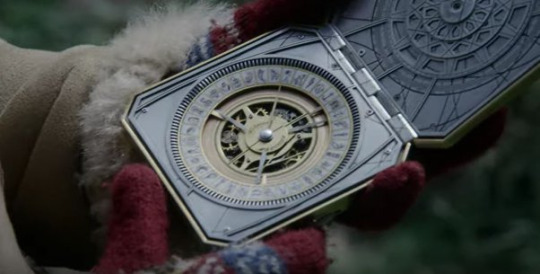
References:
"Definitions of Symbols of the Alethiometer." Archived by Wayback Machine. 20 March 2015. [https://web.archive.org/web/20150320073134/http://www.randomhouse.com/features/pullman/materials/definitions.php] Accessed 24 December 2022.
"History of the Alethiometer." Archived by Wayback Machine. 20 March 2015. [https://web.archive.org/web/20150320072443/http://www.randomhouse.com/features/pullman/materials/history.php] Accessed 24 December 2022.
"How to Read the Alethiometer." Archived by Wayback Machine. 20 March 2015. [https://web.archive.org/web/20150320072448/http://www.randomhouse.com/features/pullman/materials/materials.php]. Accessed 24 December 2022.
Pullman, Phillip. The Golden Compass. Alfred A. Knopf Books. 1995.
Pullman, Phillip. The Subtle Knife. Alfred A. Knopf Books. 1997.
Pullman, Phillip. The Amber Spyglass. Alfred A. Knopf Books. 2000.
#alethiometer#golden compass#hdm#divination#witchblr#his dark materials#pop culture magick#pop culture magic#tech magick#oracle#witchcraft
82 notes
·
View notes
Text
3d6 Alethiometer
Inspired by @a-witch-named-crow, this is just a quick and dirty 3d6 table of Alethiometer symbols and meanings from the His Dark Materials series. Interpretations aren’t given so you’ll have to read them on your own. To use, roll 3d6. The first two numbers indicate the symbol, the third points to which level of meaning. If you prefer to intuit the level of meaning, roll 2d6 instead.
I used this source for levels of meanings with a few alterations.
Hope you enjoy!
1-1 Alpha and Omega
1-2 - Finality
3-4 - Process
5-6 - Inevitability
1-2 Anchor
Can also mean the Sea
1-2 - Hope
3-4 - Steadfastness
5-6 - Snag or Prevention
1-3 Angel
1-2 - Messages
3-4 - Hierarchy
5-6 - Disobedience
1-4 Ant
1 - Busy
2 - Activity, Purpose, Intention
3 - Diligence
4 - Mechanical Work
5 - Tedium
6 - Sustain
1-5 Apple
1-2 - Sin
3-4 - Knowledge
5-6 - Vanity
1-6 Baby
1 - The future
2 - Malleability
3 - Helplessness
4 - The querent
5 - Failure
6 - Difficulty
2-1 Beehive
1-2 - Productive/Hard Work
3-4 - Sweetness
5-6 - Light
2-2 Bird
1-2 - The Soul
3-4 - Spring
5-6 - Marriage
2-3 Bread
1-2 - Nourishment
3-4 - Christ or Savior
5-6 - Sacrifice
2-4 Bull
1-2 - Earth
3-4 - Power
5-6 - Intensity
2-5 Camel
1-2 - Asia
3-4 - Summer
5-6 - Perseverance
2-6 Candle
Can also mean understanding
1-2 - Fire
3-4 - Faith
5-6 - Learning
3-1 Cauldron
1-2 - Alchemy
3-4 - Craft
5-6 - Achieved Wisdom
3-2 Chameleon
1-2 - Air
3-4 - Greed
5-6 - Patience
3-3 Compass
1-2 - Measurement
3-4 - Mathematics
5-6 - Science
3-4 Cornucopia
1-2 - Wealth
3-4 - Autumn
5-6 - Hospitality
3-5 Crocodile
1-2 - Americas
3-4 - Rapacity
5-6 - Enterprise
3-6 Dolphin
1 - Water
2 - Resurrection
3 - Succor
4 - Sea, as home
5 - Playfulness
6 - Intelligence
4-1 Elephant
1-2 - Africa
3-4 - Charity
5-6 - Continence
4-2 Globe
1-2 - Politics
3-4 - Sovereignty
5-6 - Fame
4-3 Griffin
1-2 - Treasure
3-4 - Watchfulness
5-6 - Courage
4-4 Helmut
1-2 - War
3-4 - Protection
5-6 - Narrow Vision
4-5 Horse
Can also mean constancy
1-2 - Europe
3-4 - Journeys
5-6 - Fidelity
4-6 Hourglass
Can also mean a year
1-2 - Time
3-4 - Death
4-5 - Change
5-1 Lute
1-2 - Poetry
3-4 - Rhetoric
5-6 - Philosophy
5-2 Madonna
Can also mean love
1-2 - Motherhood
3-4 - The feminine
5-6 - Worship
5-3 Marionette
Can also be an affirmative, yes.
1-2 - Obedience
3-4 - Submission
5-6 - Grace
5-4 Moon
1-2 - Chastity
3-4 - Mystery
5-6 - The uncanny
5-5 Owl
1-2 - Night
3-4 - Winter
5-6 - Fear
5-6 Serpent
1 - Evil
2 - Guile
3 - Natural Wisdom
4 - Cunning
5 - Spy
6 - Self-deception
6-1 Sun
1 - Day
2 - Authority
3 - Truth
4 - Fame
5 - Health
6 - Divination
6-2 Sword
Can also be a negation, no.
1-2 - Justice
3-4 - Fortitude
5-6 - Church, Religious Organization
6-3 Thunderbolt
1 - Inspiration
2 - Fate
3 - Chance
4 - Anger
5 - Electricity
6 - Ego
6-4 Tree
1-2 - Firmness
3-4 - Shelter
5-6 - Fertility
6-5 Walled Garden
1-2 - Nature
3-4 - Innocence
5-6 - Order
6-6 Wild Man
1-2 - Wild man
3-4 - Masculinity
5-6 - Lust
60 notes
·
View notes
Note
just realized... tarot is kinda like the alithiometer thingy from his dark materials. there are symbols that mean a bunch of things and you can read it with a book but the best readings come from when you just Know
For your consideration: @maddiviner's fascinating posts on using the alethiometer as an actual divination system.
In defense of our friends who can't read tarot intuitively and never "just Know," I will say that even when a person does happen to Know, it doesn't mean they are aware of it :) read on, you beautiful butterflies.
23 notes
·
View notes
Note
32 of the ask post
alethiometer, knife or spyglass my answer to this changes every single time but on balance probably the alethiometer i love symbols
4 notes
·
View notes
Text
I have this fucking hand drawn oracle deck that I made years ago and have yet to figure out a solid system of using... Might try to get up the courage to offer practice readings one of these days, though the art is pretty hit and miss.
Incidentally it's one of two pieces of fan art I've ever done. It's the symbols from the alethiometer in the His Dark Materials trilogy.
47 notes
·
View notes
Text
can you imagine if lyra looked at the alethiometer after learning lee had followed her to cittàgazze and it just kept showing her the griffon (lee's symbol), bread (sacrifice), and the hourglass (death) would that be fucked up or what
2 notes
·
View notes